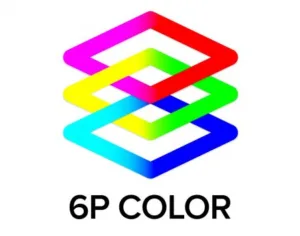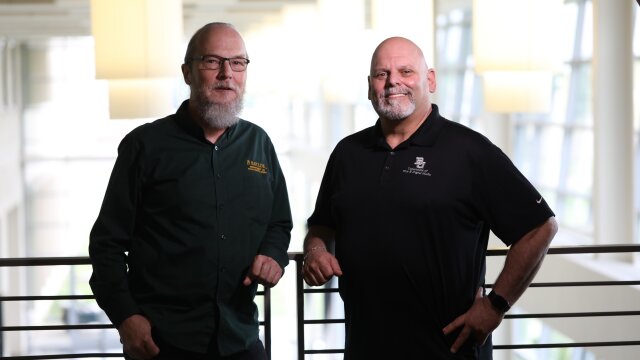Baylor University researchers unveiled a new color imaging Thursday with the capacity to dramatically increase the range of color a digital screen can display. The system – called 6P – has implications for television and cinema storytelling by transcending long-used color systems that compress color and limit it to fit the capacity of most screens.
Baylor researchers Corey Carbonara, Ph.D., and Michael Korpi, Ph.D., professors of film and digital media, lead a team of researchers and industry professionals developing the new system, which is designed to “allow the world’s first retro-compatible multi-primary color capture, processing, distribution and display system to advance the ability of every digital device on the planet to produce a wider color gamut…closer than ever before to natural viewability of the human eye.”
6P was introduced at a hybrid virtual and in-person event, “Expanding the Color Universe: The Next Frontier in Imaging,” as a part of the SMPTE + Series, which showcases developing technologies and technologists. (See the complete list of SMPTE + panelists and speakers, which includes creatives and leaders from film and television, computer and video gaming, sports and more.)
At the system’s core is an expanded palette of colors that screens can display.
“As an artist, would you rather have 24 crayons, 64 or 528?” Carbonara said. “That’s why this evolution is important.”
A New Approach
The 6P system is the brainchild of veteran Sony executive Gary Mandle, now a senior research scientist at Baylor, to address a long-held industry goal: to expand beyond the traditional RGB display system of three color primaries—red, green and blue). Mandle approached Carbonara, a longtime friend and collaborator, to share his systems-based approach, leading to a university-industry research partnership.
“Multi-primary display has been a project of a number of companies for many years,” Mandle said. “When I thought about approaching a university with the idea, Baylor was immediately my first choice. Once we talked, I didn’t need to look anywhere else.”
From those initial conversations, 6P has drawn on the expertise of a variety of industry veterans who have joined the research and development team: Mandle; Mitch Bogdanowicz, a longtime color scientist for Kodak; Jim DeFilippis, a former Fox TV executive; Steven Poster, former president of the American Society of Cinematographers and the International Cinematographers Guild; Gary Feather, display technologies expert; and Baylor film and digital media and industry colleagues.
6P’s name derived from the system’s original expansion from three color primaries to six, with the addition of cyan, magenta and yellow. While the system has grown in scope since those early iterations, the name signals that color display is no longer limited to RGB.
“In electronic displays, RGB has been so ingrained. For over 30 years, in what I’ll call the recent past, there have been a string of different demos that always fizzled out. The attitude tends to be, ‘Multi-primary has never gone anywhere and RGB is the way it has to be done,’” Korpi said. “Our approach changes that completely.”
6P uses data already captured by modern high-definition cameras that contains more colors than most screens are able to display. While the data is there, the files are formatted to fit the limitations of the screen—as Korpi described, “squished down” based on the limitations of the display.
Using a proprietary blend of algorithms, matrices and look-up tables, the system draws on color science and high-capacity processing to move beyond the traditional RGB limitations and show the colors previously formatted out of the display. A visual path is found in the color gamut. Shaped like a thumbnail, the gamut contains colors visible to the human eye. Within that range, only a subset can be displayed on screen. In the case of RGB, the primaries form a triangle that limits the range of visible colors to a relatively small portion of the gamut.
“One of the things that astronauts tell us is how beautiful our planet is from the International Space Station, but the images they see captured don’t do justice to what they see with the human eye,” said Dylan Mathis, BA ’94, MA ’96, NASA integration manager for operational programs. “The idea of expanding the color palette—to show the colors between the colors—is exciting, to display images that better communicate the wonder of this beautiful planet.”
As 6P moves past three primaries, it enables color display at the far ranges of the color gamut unlimited by any number of primaries. The ability to further use already-captured images helps 6P clear hurdles in adoption and installation that have vexed previous attempts to expand beyond RGB.
“The real advantage is that this is backwards compatible with almost every system that exists today, so nothing would need to change within the structure of the technology to use this system,” Poster said. “This is compatible with systems currently being used in the motion picture industry and gives you just that much more color gradation than you ever would have.”
Enhanced storytelling
As 6P has grown, external organizations have either remained or become interested in their work. SMPTE and NASA are participating in the introductory event, and NASA formed an umbrella Space Act Agreement with Baylor to facilitate collaboration and information sharing.
“NASA will provide 6P with unique imagery that no one else has so they can see how it works within the systems they’re developing,” Mathis said.
The SMPTE + event features professionals from SMPTE and NASA, color scientists, sports and video game executives, and a variety of media sectors who utilize color in visual storytelling. Among the panelists is Poster, a veteran cinematographer who has worked on numerous films, including Close Encounters of the Third Kind, Blade Runner and Donnie Darko.
“It’s a real shame to currently have high-end technology to tell stories with but to know that you’re limited in terms of showing the color gradations that exist in nature,” Poster said. “Every color has emotional impact on a viewer’s physiology. As a storyteller, it just makes perfect sense to have, the colors in between the colors to display.”
Baylor technology commercialization
6P’s further growth will take place within the framework of 6P Color Inc., the company formed to develop and commercialize the technology through Baylor’s Lab to Market Collaborative (L2M). Housed within Baylor’s Office of the Vice Provost for Research, L2M is joint effort between Baylor, Blueprints Lab and local venture capital firm Waco Ventures to advance technologies from the idea phase into the marketplace, where they can have real world impact. 6P Color Inc. was the first such company formed through L2M.
“Our core as a University is not technology commercialization,” said Todd Buchs, assistant vice provost for research, technology commercialization and industry engagement. “But, we want to see that take place, because every inventor wants to see their invention make a difference. That can be a difficult process if you’re not skilled in that. And that’s why we have teammates to advance disruptive technologies like 6P.”
The $2.5 million in research funding acquired through the Lab to Market process supports Baylor’s research growth as an R1 institution, advancing Baylor’s Illuminate research vision as it funds 6P.
“It’s very appropriate that this is the first company formed through this ecosystem,” said Brian Woods, Waco Ventures operating partner and 6P Color Inc. chairman. “It’s a rare and unique opportunity to have a product that will affect most humans on the planet.”
About BAYLOR UNIVERSITY
Baylor University is a private Christian University and a nationally ranked research institution. The University provides a vibrant campus community for more than 19,000 students by blending interdisciplinary research with an international reputation for educational excellence and a faculty commitment to teaching and scholarship. Chartered in 1845 by the Republic of Texas through the efforts of Baptist pioneers, Baylor is the oldest continually operating University in Texas. Located in Waco, Baylor welcomes students from all 50 states and more than 90 countries to study a broad range of degrees among its 12 nationally recognized academic divisions.


